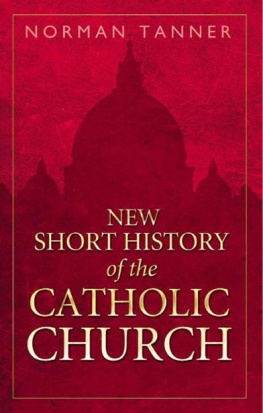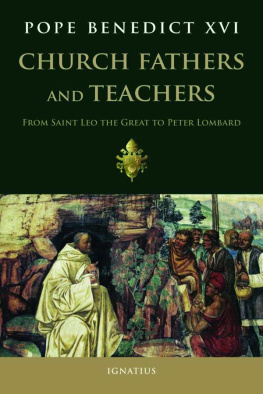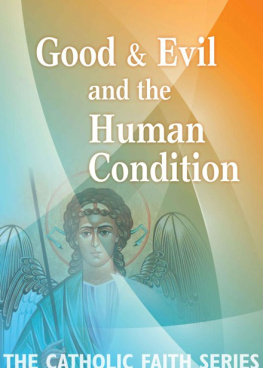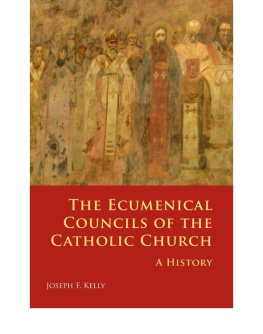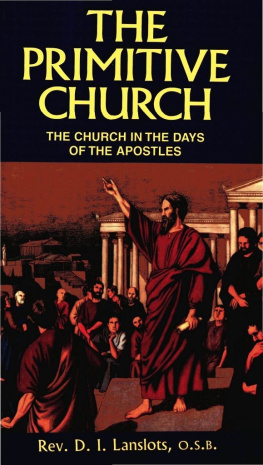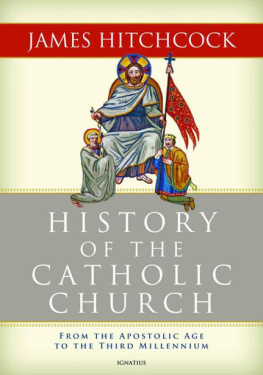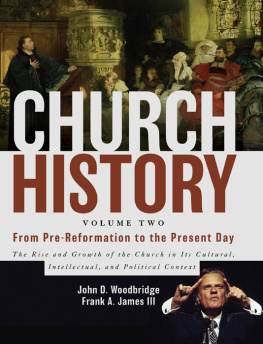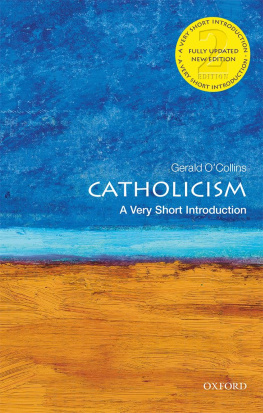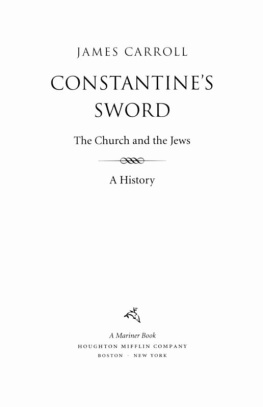
New Short History of the Catholic Church
NORMAN TANNER

Published by Burns & Oates
A Continuum imprint
The Tower Building
11 York Road
London
SE1 7NX | 80 Maiden Lane
Suite 704
New York
NY 10038 |
www.continuumbooks.com
Copyright Norman Tanner, 2011
All rights reserved. No part of this publication may be reproduced or transmitted in any form or by any means, electronic or mechanical, including photocopying, recording or any information storage or retrieval system, without prior permission from the publishers.
First published 2011
British Library Cataloguing-in-Publication Data
A catalogue record for this book is available from the British Library.
ISBN: HB: 978-1-4411-4020-3
Designed and typeset by Fakenham Prepress Solutions
Contents
Nihil obstat and Imprimatur
Francisco J. Egana SJ, Vice-Rector, Gregorian University, Rome
Dedication
For Angela and John,
Gerard and Jenny,
with many thanks
Acknowledgements
History, especially church history, has for long been a passion in my life. So I take this opportunity to thank all who have encouraged and helped me in this charism: teachers of history at the schools of Woldingham Convent and Avisford; those at Ampleforth College, especially Thomas Charles-Edwards, William Price (headmaster), W. A. Davidson and Basil (later Cardinal) Hume; teachers and colleagues at Oxford University, especially James Campbell, Peter and Jill Lewis, James OHiggins, and the supervisor of my doctoral thesis William Pantin; most recently, my colleagues at the Gregorian University in Rome. I am grateful to my Superiors in the Society of Jesus for fostering my studies in Church History, for the opportunities to teach in many different countries opportunities which have greatly enriched my appreciation of the Catholic church worldwide and for encouraging me to write. Among many editors and publishers, I thank especially Martin Redfern of Sheed and Ward, who had the courage to publish Decrees of the Ecumenical Councils ; and Robin Baird-Smith of Continuum, who commissioned the present work and has sustained the project with fortitude and patience.
For the present book, I am indebted to all the above persons and to many more. The short Bibliography gives some indication of these extended debts. I take this opportunity to express my thanks to all those concerned. Among more particular debts, I thank Dr Frank Lawrence of Trinity College, Dublin, for help on the section on music in Chapter 3. In addition, I wish to thank the communities of the following institutions who gave me hospitality and inspiration during the research and writing of the book: the Gregorian University in Rome, Campion Hall in Oxford, the Jesuit Theologate in Nairobi and, in India, the Papal Seminary in Pune and the Regional Seminary in Shillong.
Norman Tanner SJ
Gregorian University, Rome
20 September 2010
Notes and Abbreviations
References to publications. References to books and articles are given in the body of the text, not in footnotes. For the works referred to frequently, see Abbreviations below. Other references are given in the following form: author or first word(s) of title, as appropriate, followed by the date of publication and the pages (or numbers etc.) referred to, thus: (Baur, 1998, p. 443). The full title of the book or article can be found in the Bibliography, under the chapter in which the reference occurs.
Bible. In references to Scripture, a recognizable title of the book is given together with the chapter and verse, thus: Genesis 4.13.
Dates of birth and death. For most individuals who appear in this book, the year of birth and, in many cases, that of death is not known with certainty. The policy has been to give dates wherever possible, rather than question-marks (?) or spread-dates (1370/75), but the year indicated often indicates an approximate rather than a definite date.
Abbreviations
c. | circa /about |
+ | date of death |
Decrees | Decrees of the Ecumenical Councils , ed. N. Tanner, 2 vols, Georgetown and London 1990. The pagination is continuous through the two volumes, therefore only the page is indicated. |
DS | H. Denzinger and A. Schnmetzer (eds), Enchiridion Symbolorum, Definitionum et Declarationum de Rebus Fidei et Morum , 37th edn, Freiburg im Breisgau 1991. |
Mansi, Conciliorum | J. D. Mansi and others (eds), Sacrorum Conciliorum Nova et Amplissima Collectio, 53 vols, 17571927 |
Migne, PG | J. P. Migne (ed.), Patrologia Graeca , 162 vols, Paris, 185766, |
Migne, PL | J. P. Migne (ed.), Patrologia Latina , 221 vols, Paris, 184464, |
Map: The Mediterranean World

Introduction
From an early age history has been crucial for the people of God. Much of the Old Testament recounts the history of the Jewish people, while the story of Jesus and the early Church is told in the New Testament. The history of the Catholic church the subject of this short book forms perhaps the most fascinating story of any institution in world history. But for Catholics this history is more than just interesting, it is crucially important on account of the normative role of Tradition. That is to say, Catholics have held firmly to the belief that the Bible must be accompanied by an awareness of how its message has been lived and interpreted through the centuries, by a sense of how the contents of Scripture have been clarified by the teaching authorities within the Church and through the life, prayer, study and struggles of Christians. Tradition and the history of the Church complement the development of doctrine, they complete our understanding of Christ as the fullness of Truth and of Gods revelation to us.
Fortunately, writers have come forward through the centuries to record the history of the Church and so to help us with the necessary Tradition. Eusebius of Caesarea, writing in the fourth century, is acclaimed as the Father of Church History. Three centuries later Britain and France produced two church historians of the highest quality, Bede and Gregory of Tours. Church historians abounded in the Middle Ages and, with more polemical edge, throughout the period of Reformation and Counter-Reformation. The nineteenth century witnessed many advances in historical scholarship which greatly affected the writing of church history. The twentieth century has reaped the fruits of these advances through multi-volume histories of the Church as well as shorter works. The present book fits squarely into the latter category of a short history.
The book divides conveniently and naturally into five chapters. Chapter 1 covers the early Church of the first four centuries, the period when the boundaries of the Church mainly coincided with those of the Roman Empire. During the first three centuries persecution was never far from the Church and greatly influenced its history. The fourth century witnessed the conversion of emperor Constantine to Christianity and resulted in first freedom and then a privileged position for the Church the establishment of Christianity as the official religion of the Empire.

